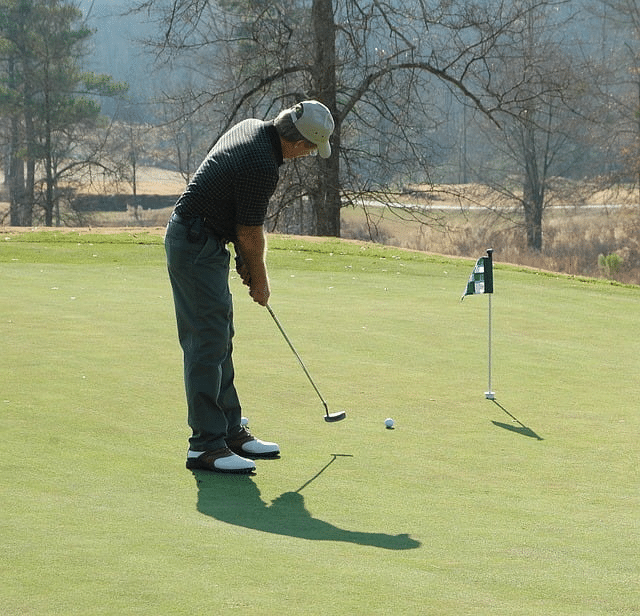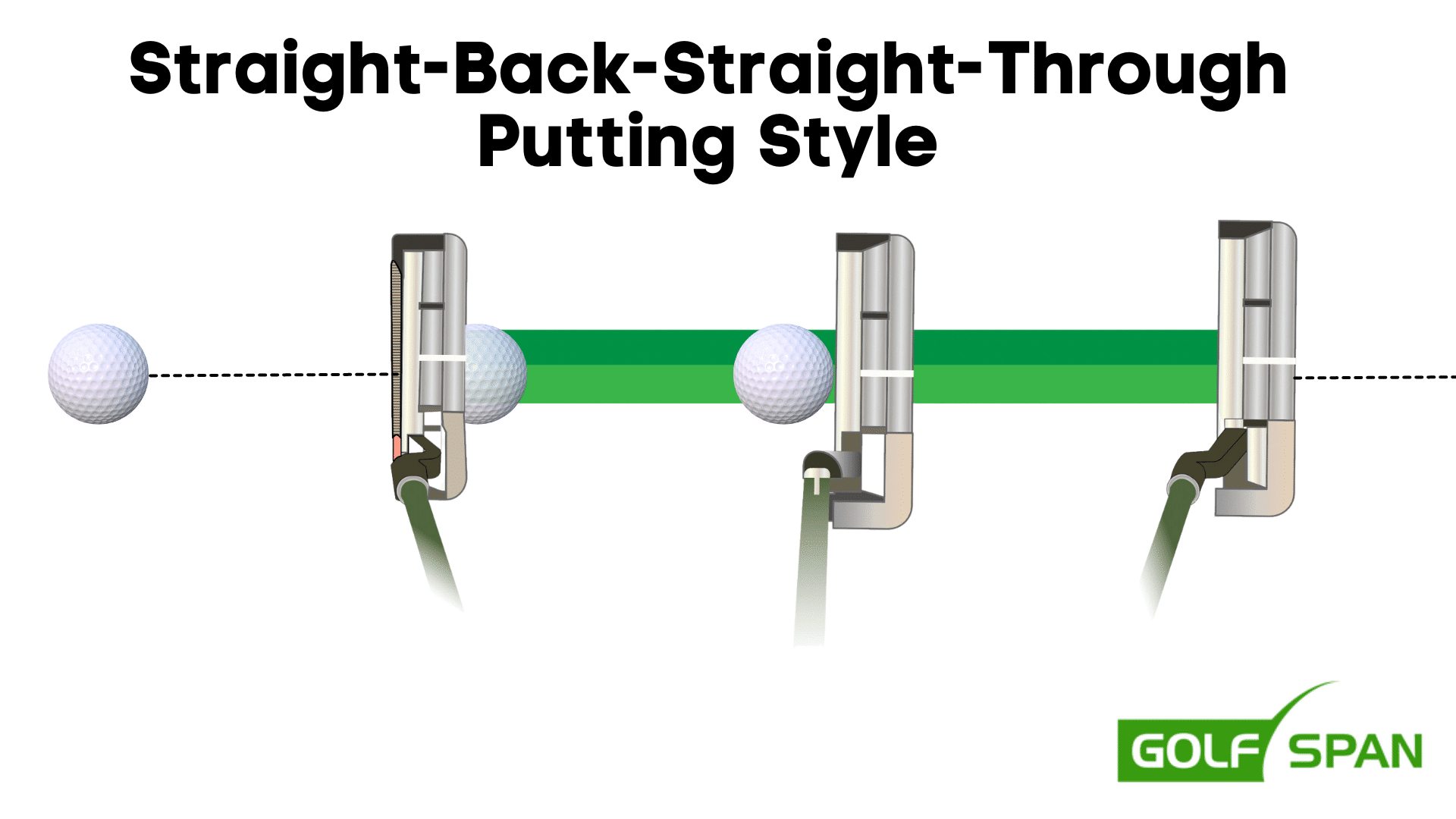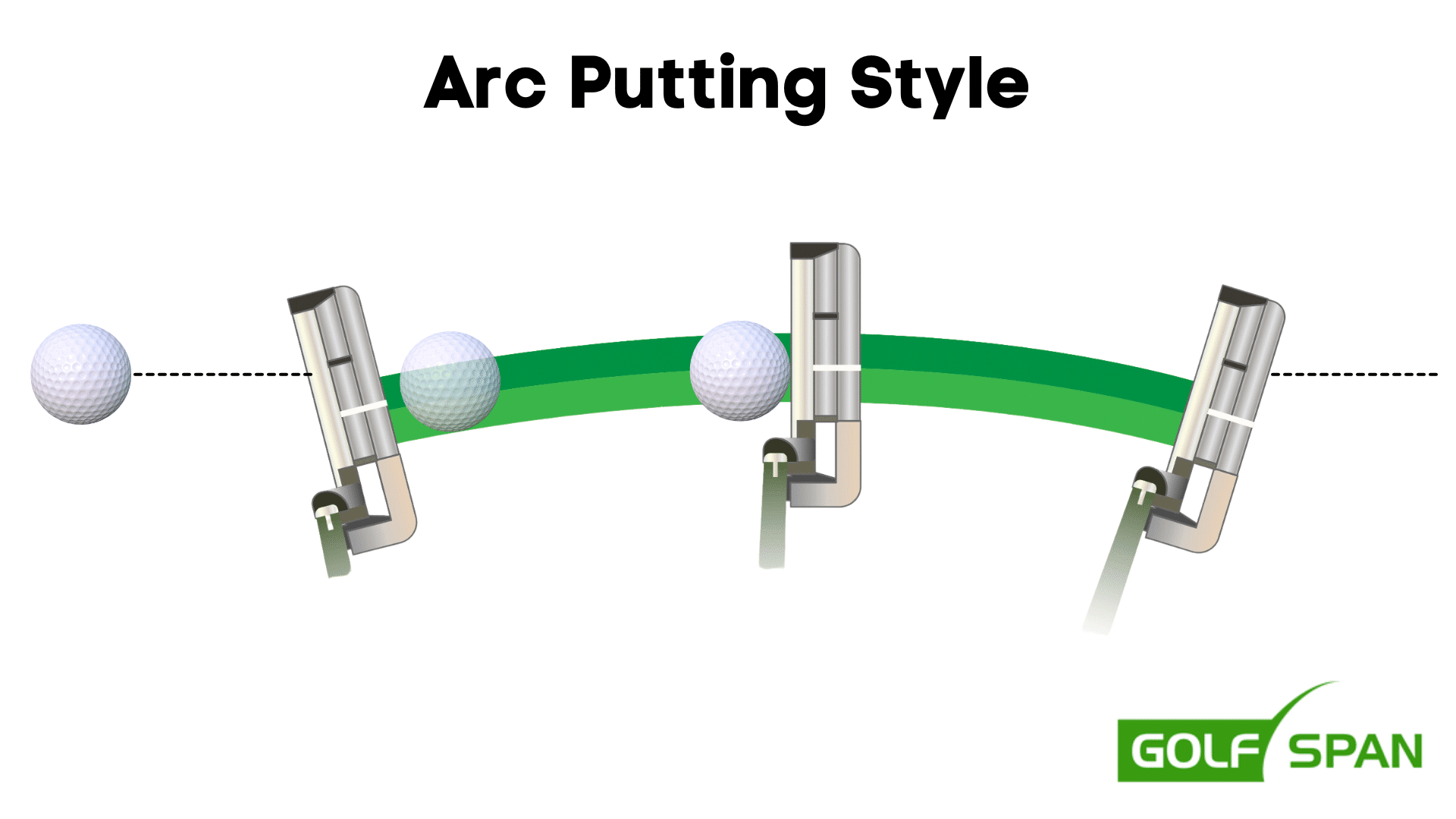Good putting is a mix of proper setup, technique, tempo, green reading, and self-belief in one’s ability to putt well. Putting is a game within a game and an essential ingredient to good scoring in golf overall.
Did you know that putting makes up approximately 40% of all the strokes you take in a round? That is a significant percentage indeed.
This article will solely look at the putting stroke from a technique standpoint. There will be some mention of the setup, but the primary focus will be on putting stroke mechanics
The 7 best putting stroke tips include:
- Keeping your eyes over the ball
- Ensuring your putting grip is a good for your style
- Your lead wrist leads the way
- A steady head and body anchor the stroke
- The ratio you need to know in putting: 2:1
- Find the correct putter for your putting style
- The ball and your stroke — alignment aids
Each step is crucial to putting effectively — ignore one, and your technique could fall apart. Consider reading right to the end to gather all the knowledge you need for success.
What Is a Putting Stroke?

The putting stroke is how you take your putter head back and through as you putt the ball. There are two primary styles of stroking a putt: the straight-back-straight-through method, and the arc style method.
Those that use the straight-back-straight-through stroke must keep the putter on the target line during most of the stroke. A longer stroke, necessary for longer putts, will have a slight arc on the backstroke.
Those that use the arc-style golf putting stroke take the putter back slightly to the inside of the target line. They then follow that arc back to impact and follow through by bringing the putter back slightly to the inside of the target line. Tiger Woods is well known to putt with an arcing stroke
Read More: Putting Tips to Take 5 Strokes Off Your Score
Proper Putting Stroke Techniques: Step-By-Step
Straight-Back-Straight-Through

Here’s a simple step-by-step guide on how to properly stroke a putt with the straight-back-straight-through method (my preference):
- Get set up with your eyes over the ball and your body aligned parallel to the left of the target line (for righties).
- Keep the head and body very still as you start your backstroke.
- You will be rocking the triangle created by your shoulders at the top, running parallel to the left of your target line (for righties), and your arms hanging straight down from your shoulders. You complete this triangle with your hands gripping the putter.
- The putter swings back with the centerline of the head moving away from the ball and on the target line. With a longer stroke, necessary for longer putts, this stroke type has a small degree of arc.
- The putter then swings forward and back down the target line, with the centerline of the putter head moving on that line.
- There is very little, if any, wrist rotation or movement. Your lead wrist will stay flat and move toward the target.
- The head and body remain still as you rock the triangle on through to the finish of the stroke.
- After you finish your through stroke, keep your head steady and looking down at the spot where the ball was at set up. Hold it there for the count of three.
Arc Style

Here’s a simple step-by-step guide on how to properly stroke a putt with the arc style method:
- Get set up with your eyes over the ball and your body aligned parallel to the left of the target line (for righties).
- Keep the head and body very still as you start your backstroke.
- You will be rocking the triangle created by your shoulders at the top, running parallel to the left of your target line (for righties), and your arms hanging straight down from your shoulders. You complete this triangle with your hands gripping the putter.
- The putter swings back on a slight arc, with the centerline of the putter head moving away from the ball just inside the target line.
- The putter then swings forward and returns to the ball on the same arc line it went back on.
- There is some minimal wrist rotation in this stroke type. Your lead wrist will need to be flat at impact. Just after impact, the face will continue to arc on the post-impact side of the stroke. This style stroke is a smaller version of a full swing in golf.
- The head and body remain still as you rock the triangle on through to the finish of the stroke.
- After you finish your through stroke, keep your head steady and look down at the spot where the ball was at set up. Hold it there for the count of three.
Check This Out: How to Putt and Become a Master on the Greens
7 Tips to Improve Your Putting Stroke
The following seven tips will help you perfect your putting stroke and the results you get from it. However, keep in mind; there are other aspects of putting that you need to work on beyond the stroke. These include reading greens, for example.
Tip #1: It’s All in the Eyes — Make Sure Your Eyes Stay Over the Ball
As you get your body set over the ball and ready to putt, you must ensure your eyes are directly over the ball. This also means your eyes will be over your target line.
If your eyes are too far inside your target line, the chances of pushing putts are much higher. If your eyes are too far outside the target line, the chances of pulling putts are much higher.
A great way to check your eye position: set up to the putt as usual, and hold a golf ball between your eyes, just over the top of your nose. Drop the ball straight down. If your eyes are positioned over the ball, the ball you drop should hit the ball on the ground.
Tip #2: Grip Check: Is Your Putting Grip Good for Your Putting Style?
The putter face is said to be responsible for 90% of your golf balls’ start direction. Your hands control what the face of your putter is doing at impact. With that in mind, how you grip the putter will significantly impact the face at impact.
There are many different putting grip styles. The traditional putting grip, the lead hand low style, and the claw are a few examples. Knowing what is best for you and your ability to square the face up best at impact will come down to trial and error.
Trying several different putting styles while you practice on the green will help you find what is best for you. A great way to do this is as follows:
- Pick a reasonably straight putt roughly five feet from the hole.
- Place two tees next to each other, creating a “gate.” The tees should be just wider than the width of a golf ball.
- Place a ball roughly a foot behind the center point of the gate you created.
- You will then test your face control by putting balls through the gate and doing so using several different grip styles. Through trial and error, find the best grip style that helps you start the ball on line. Balls hitting either tee means you are not starting the ball on a good start line.
The video above demonstrates this classic putting drill.
Tip #3: Your Lead Wrist Leads the Way
Sticking with your hands as the theme, and their impact on the putter face at impact, I want to mention your lead wrist. Much like in your full swing, where a good lead wrist position plays a significant role in creating a good impact position, the same can be said in putting.
No matter how you grip the putter, your lead wrist must be flat as your putter head moves into impact. If you have a cupped lead wrist at impact, you will be rotating the putter face too much. This will lead to inconsistency.
A tip for working on this is to practice putting with your glove on. Make sure the logo on your glove remains moving toward your target. If you cup your lead wrist, the glove’s logo will point more toward the sky at impact.
Tip #4: A Steady Head and Body Anchor the Stroke
A steady head and body are essential for good putting. As mentioned earlier, the head and body will remain still as you rock your triangle back and through during the stroke. There is almost no body rotation.
As a reminder, the triangle begins with your shoulders at the top, running parallel to the left of your target line (for righties), and your arms hanging straight down from your shoulders. The triangle then forms when your hands grip the putter.
The steadier you can keep your head and body, the more stable of a putting stroke you will have.
Tip #5: The Ratio You Need to Know in Putting: 2:1
All great putters putt at a rate of 2:1. This means that their through stroke is two times as fast as their backstroke, regardless of the length of the putt.
You may ask, how can that be the case? Surely there must be a difference between a five-foot putt and a fifty-foot putt. The answer is that there is indeed a difference. However, that difference is not with your tempo. The difference is in the length of the stroke.
You will have a longer stroke for longer putts, but the rate of your backstroke and through stroke should not change. Again, the ideal ratio is a 2:1 rate. The Blast Motion Sensor is a fantastic training aid to measure and train these aspects of the stroke. Look for more on that in a few!
Tip #6: Find the Correct Putter for Your Putting Style
It is essential to understand that you need to find a putter that matches your putting style. As discussed earlier, there are two primary types of putting strokes. The first is the straight-back-straight-through method, and the second is the arc-style method.
These two styles have specific putter designs that match up best for each.
A center-shafted, face-balanced putter is best for those that putt with the straight-back-straight-through method.
For those that putt using the arc style method, a heel-shafted putter that is toe weighted or has a lot of toe hang is the best.
Tip #7: The Ball and Your Stroke — Alignment Aids
Having some alignment aid on your golf ball has become commonplace. However, until recently, you had to put these lines on your golf ball yourself using an alignment drawing tool.
Today, many major golf ball manufacturers put different alignment aids on their golf balls. Some manufacturers even make two-tone balls with the idea that you can use the centerline created by the two-color design for alignment.
Use these lines on the ball, especially for shorter to mid-length putts. They will work wonders for your putting by consistently getting the ball started on the correct start line.
More Great Info: Left Hand Low Putting Grip: What Is It, Benefits, & How To Do It
Straight Back and Through vs Arc: Which Is the Best Putting Stroke?
Although it’s not very satisfying, there is no de facto best-putting technique. Both styles have their merits and are used effectively by golfers all over the world.
Sure, straight back and through is easier in terms of consistency, but arc-style putting feels more natural for many players. We recommend trying both to see which you prefer.
Ultimately, you should focus more on exercising good putting stroke fundamentals rather than fussing over choosing the correct putting stroke.
Training Aids for a Better Putting Stroke
The following are some fantastic training aids that I use with my students. These will help with perfecting your putting stroke.
Blast Motion
As mentioned in tip #5, the Blast Motion sensor and its accompanying app are unique tools for practicing your tempo. The app also measures your backstroke time, your through stroke time, how square your face is at impact, and much more. As a result, Blast Motion is a fantastic, one-of-a-kind training aid.
Eyeline Golf Circuit Trainer
The Eyeline Golf Circuit Trainer is a great training aid to dial in your putting. Golf Span ranked this model as the best-putting training aid this year.
This training aid by Eyeline Golf offers three putting trainers in one set. It allows you to work on your path, line, and ball position. They include twelve putting drills complete with video instructions.
Read On: The Best Putting Aids
Frequently Asked Questions
What Are the 2 Primary Types of Putting Strokes?
The two main types of putting strokes are the straight-back-straight-through and the arcing style. The preferred method taught by most coaches is the straight-back-straight-through stroke because it’s more beginner-friendly. Arc-style puts, on the other hand, follow a path slightly inside the target line.
Should I Use a Straight Back and Through or an Arc Putting Stroke?
The argument of straight back and through vs arc putting is hotly debated in the golfing community. While straight back is generally easier to learn and more consistent, arc putting feels more natural. Ultimately, we feel it comes down to personal preference. Try both, see which is best for you, and stick with it.
Should You Hit or Stroke the Putt?
The action is referred to as a stroke, so with that said, it is best to putt the ball with that term in mind. Many years ago, when greens were much slower speeds overall, golfers would indeed "hit" putts more than stroke them. That is no longer the case in the modern game.
What Causes an Out-to-In Putting Stroke?
An out to in putting stroke can be a result of many factors. One of the main causes is poor shoulder alignment. Ensure your trailing shoulder is square to your putting line to break this bad habit.
More From Golf Span: The Best Putting Drills to Sink More One Putts
Summing It Up
One of golf’s most important aspects is putting. With this game within a game accounting for nearly 40% of all the shots taken in a round, it is clear that a good simple putting stroke is vital to shooting quality scores.
Putting requires many qualities from a golfer to become proficient at it. The ability to read putts and build great touch are two examples.
The tips shared today focused on the mechanics of the stroke itself. Use these as you practice; if you put in the hours, you’ll eventually develop a near-perfect putting stroke.
As a final point, choose either a straight back and through putting stroke or an arcing putting stroke and stick with it. Don’t chop and change. Only pros like Jack Nicklaus can get away with this.
Brendon is Class A PGA Professional and founded Little Linksters, LLC, and its nonprofit arm, the Little Linksters Association for Junior Golf Development. He won 25+ prestigious industry honors, including the 2017 PGA National Youth Player Development Award. He graduated from the PGA of America Management Program and has a handicap index of 7.8.
He has played golf for over 40 years and currently plays twice a month at the Eagle Dunes Golf Club near Sorrento, Florida. He loves Srixon clubs and plays a ZX5 driver with Z 585 irons. He's written over 60 articles on GolfSpan and specializes in sharing tips to improve your golf game. You can connect with Brendon at LinkedIn, X, IG, FB, his website, or BrendonElliott@pga.com.







